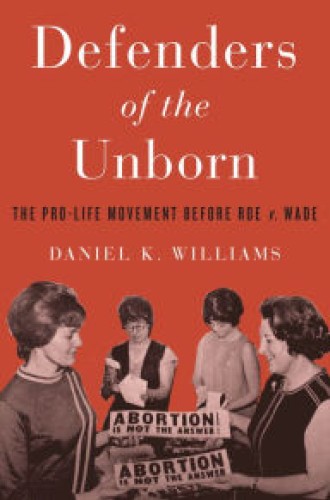When pro-lifers were progressives
Most of us only know the pro-life movement after Roe v. Wade. But there's a fuller history—with surprising turns.
In her first speech after clinching the Democratic nomination for president, Hillary Clinton spoke to one of her core constituencies—supporters of Planned Parenthood. As she reaffirmed her support for legalized abortion, Clinton faulted the critics of Planned Parenthood for being concerned more about prenatal life than postnatal life. “The same politicians who are against safe and legal abortion,” she observed, “are also against policies that would make it easier to raise a child . . . They are for limited government everywhere except when it comes to interfering with women’s choices and rights.”
Clinton’s complaint may not be fair to every opponent of abortion, but she’s mostly right. In recent decades, the voices most opposed to abortion are generally the ones most reluctant to support—much less expand—the health and welfare programs that serve mothers and children.
Read our latest issue or browse back issues.
But it was not always so, says Daniel K. Williams, a historian at the University of West Georgia. He argues that the pro-life movement that emerged in the mid-20th century was at root a liberal one. It viewed protecting the unborn as entirely consistent with New Deal and Great Society efforts to support low-income families. That’s how most Roman Catholics viewed the matter, and the pro-life movement from the 1950s into the 1970s was overwhelmingly Catholic.
Catholic leaders cited church texts against abortion, but they also affirmed church statements on the need to fight poverty and support workers’ rights and a living wage. Williams devotes a chapter to Minnesota Citizens Concerned for Life, a group created to fight any loosening of restrictions on abortion but which had a broader agenda. “The solution to the woman’s problem is neither to offer her abortion, nor merely to prohibit it, but rather to demonstrate that there are humane alternatives,” said a MCCL brochure in 1971. “This means that we must provide counseling, medical care, financial assistance, homes for unwed mothers, adoption agencies, and effective welfare programs.”
Williams is keen to highlight as well the opponents of abortion who joined protests against racial segregation, nuclear weapons, the Vietnam War, and capital punishment. For these activists, the defense of fetal rights was part of an expansive defense of all human rights—a precursor to what later Catholics would call a “seamless garment” ethic of life.
The 1970s proved to be a crossroads. At the beginning of the decade, the pro-life movement counted among its supporters such leading liberal Democrats as Hubert Humphrey and Ted Kennedy. Key figures in the movement were Kennedy’s brother-in-law Sargent Shriver, who had spearheaded the antipoverty efforts of the Johnson administration, and his wife Eunice Kennedy Shriver, founder of the Special Olympics. Black supporters included civil rights leader Jesse Jackson, who argued that the failure to recognize the fetus as a person resembled the failure of whites to recognize the personhood of black people. Leaders of the Black Panthers called legalized abortion part of white America’s attack on the black population. In 1976, a proposed Human Life Amendment to the Constitution, designed to protect life from the moment of conception, was supported in equal numbers by Democrats and Republicans.
In short, abortion in the 1970s was a controversial issue, but it was equally controversial within both major political parties and apart from political ideology.
By the end of decade, the landscape had decisively shifted. The Supreme Court’s 1973 ruling in Roe v. Wade made abortion legal nationwide on the basis of a right to privacy. The women’s movement that burgeoned in the 1970s pressed politicians to defend the court’s stance, arguing that anything less would spell a return to the barbarism of back-alley abortions. Pro-life Democrats began to distinguish between their personal opposition to abortion and their public duty to support a woman’s right to choose. The party headed toward that watershed moment in 1992 when Pennsylvania governor Robert Casey was denied a speaking role at the national convention solely because of his opposition to abortion.
On the Republican side, whereas presidents Richard Nixon and Gerald Ford had vacillated on the issue, Ronald Reagan embraced the antiabortion cause. His election in 1980 and again in 1984 on an agenda of low taxes and small government firmly joined the antiabortion movement to the explicit rejection of the social welfare and antipoverty programs that Humphrey, Kennedy, and Shriver had championed. Meanwhile, evangelical Christians, heretofore largely indifferent to the topic, took up the fight against Roe as part of broader resistance to the forces they saw undermining traditional moral values.
Williams provides a valuable, granular account of the politics of abortion, especially the legislative debates before Roe, and he offers an important reframing of the history. He begins the story with the Catholic response to the efforts by Protestant and Jewish doctors who, starting in the 1930s, sought to liberalize abortion laws. These doctors wanted to aid their female patients and align the law with actual medical practice. Despite prohibitions, many doctors and hospitals performed abortions for the sake of a mother’s health. Loosening legal restrictions was a way to protect doctors from potential lawsuits, offer a safe alternative to the thousands of women each year who risked unauthorized abortions, and save the several thousand who died each year from botched illegal operations. To regularize the practice, some hospitals formed committees to decide which abortions were permitted. Committee rulings varied widely from place to place, however, and were often criticized as too lax or too rigid. Lawmakers began to step in and the political battle commenced.
Though Williams does not dwell on this feature, his account of this era suggests some of the difficulties of enforcing rules against abortion. A rule that allows abortion only when it protects “the health of the mother,” for example—a stance widely endorsed by the American public—requires considerable interpretation, since medicine is a practice of percentages, not guarantees. At what level of risk is a woman’s life or health put in danger? How is health interpreted? And above all, who is to decide these matters? Turning decisions over to a hospital committee was not satisfactory to activists on either side in the 1950s, and it’s hard to imagine a similar arrangement being more acceptable in our time. And it would not resolve the political and moral debate.
Following the political realignment of the 1970s, Williams says, the principled opponents of abortion had little choice but to align themselves with the GOP, since only Republicans embraced their goal of prohibiting abortion. But this alliance was painful for those in the movement who still supported antipoverty programs and a broader liberal agenda. For them, the marriage with the GOP was always uneasy.
Williams laments that a liberal center did not hold—that it was not possible to join support for vulnerable unborn children with support for vulnerable families and pregnant women and for other progressive goals. He gestures toward a road not taken, offering a glimpse of a different kind of abortion politics and a different kind of liberal politics.
His argument would be more compelling if there were more evidence of such uneasiness within Republican ranks. What’s most striking about the history Williams relates is how quickly the ideological landscape assumed the polarized state we know today, one in which—as Williams readily acknowledges—few politicians would venture to couple an antiabortion stance with opposition to the death penalty, or expanded antipoverty programs, or support for a living wage. For most pro-lifers who shifted to the GOP, defense of the unborn was a paramount issue, and they readily acquiesced to other elements of an increasingly conservative Republican agenda. The only major voice trying to hold together the old liberal consensus was that of the Catholic bishops, as represented by the United States Conference of Catholic Bishops, and there’s no evidence they injected much unease into the GOP.
If the official pro-life movement that emerged in the 1980s showed little reluctance in embracing conservative social and economic policies, it showed even less reluctance in embracing conservative views on gender. The pro-life movement aligned itself with traditional gender roles at the workplace, home, and athletic fields, lobbying against Title IX legislation and the Equal Rights Amendment, stances that were anathema to a new generation of liberal Democrats.
By Williams’s own account, it’s not clear that the liberal pro-lifers’ marriage with the GOP has ever paid much of a dividend. Opponents of abortion have managed to impose restrictions on access, but the right to abortion has been consistently defended by voters and courts. Meanwhile, abortion rates have dropped significantly in recent years as women have gained better access to education, health care, and contraception—in large part thanks to the social welfare programs that old liberals endorsed and modern conservatives have resisted. Williams cites the words of a Catholic pro-life leader who admitted in 2013 that the best way to reduce abortion rates was to “fight poverty.”
Nevertheless, Williams thinks liberals sacrificed something important in liberalism when they abandoned their opposition to abortion. In his terms, they turned away from the rhetoric of solidarity with the vulnerable and toward a “rights-based individualism” in which individual autonomy trumps solidarity. Williams underplays the ways that rights-based liberalism has been genuinely liberating for women (and men)—not to mention for gay people, black people, Hispanic people, and other minorities. Yet his point still has some force. A liberalism that can focus only on individual rights loses the ability to articulate a communal worldview or appeal to a larger vision of the common good. In the case of abortion, to focus only on the good of individual choice means avoiding talk about what makes a particular choice a good one. The irony for liberals is that on most other issues—such as the environment, gun control, and health care—they take the opposite view: they think individual rights need to be defined and limited by a broader vision of what makes for a good society.
This book is relevant to mainline Protestants’ own effort to fashion a position on abortion. In their official statements, mainline Protestants have tried to straddle the left-right divide, expressing unease with abortion as a blanket right but being unwilling to prohibit it. A statement by the United Methodist Church, for example, speaks of the “sacredness” of the unborn child while admitting there are “tragic conflicts of life with life that may justify abortion.” In a similar vein, the Episcopal Church declares that “all human life is sacred from its inception” and that therefore every abortion has “a tragic dimension” and should be performed “only in extreme situations.” In effect, mainline Protestants have tried to hold on to the language of solidarity with the unborn while detaching it from any legal prohibitions. What solidarity with the unborn means is left up to the individual to decide and the religious community to encourage, not the government to enforce.
The language of “tragedy” distances mainline Protestants from the kind of full-throated endorsement of abortion rights expressed by people like Planned Parenthood president Cecile Richards or Katha Pollitt in her book Pro: Reclaiming Abortion Rights. Both argue that abortion should be seen as a positive good. Pollitt scoffs at all talk of “tragedy.” Such rhetoric, she says, is simply a way to make women feel ashamed of choosing abortion and to implicitly justify regulations that deny access to abortion.
Hillary Clinton once spoke of making abortion safe, legal, and rare. Of late, the reference to “rare” has dropped out of the phrase, perhaps because it carries a whiff of disapproval. If abortion is good for women, why should it be rare? “Rare” is a vestige of the moral judgment that a society in which abortions are rare is better than one in which they are common. That used to be a sliver of common ground in the debate, but perhaps even that is slipping away.
I sense among liberal Protestants these days a tendency toward silence on abortion. The language of “tragedy” offers no purchase amid the policy options on offer. It seems either mere hand-wringing or, as Pollitt suggests, to play into the hands of a regressive right wing.
Yet if solidarity with the unborn is something mainline Protestants want to inculcate, some kind of speech about it is necessary. Such solidarity is implicit in every ritual of grief accompanying a miscarriage, and every medical effort to rescue a premature infant. Even with the stipulation that solidarity with the unborn is a subject for theological reflection, not state action, it still needs to be talked about. Williams’s book might help start that conversation.







